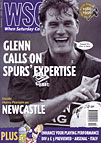 Steve Davies takes a look at the figures in the annual review of football finance, which as expected offer good news for the big boys and bad for everyone else
Steve Davies takes a look at the figures in the annual review of football finance, which as expected offer good news for the big boys and bad for everyone else
Premier League clubs are on the gravy train while the Endsleigh League drift toward oblivion. That, at least, is the commonly held view, and the report prepared by Deloitte & Touche into football finance provides an opportunity to see whether it is supported by the facts.
The report is now annual, and the fact that a firm of Chartered Accountants is prepared to invest substantial resources into preparing it as part of its marketing is a demonstration in itself that football is now a multi-million pound business.
Turnover of Premier League clubs rose from £241 million in 1993-94 to £322 million 1994-95, an increase of just over one third in a space of 12 months. The turnover of Endsleigh League clubs for the same period actually fell very slightly, with the result that the Premier League grabbed 68.9% of the total turnover as against 62.4% for the previous season.
These and other not so startling statistics, such as the fact that Manchester United, Newcastle, Arsenal, Tottenham and Liverpool had a turnover between them of £10 million more than the entire Endsleigh League, all support the view that the rich clubs are getting richer and the poor clubs left behind.
The report also shows that some of the largest clubs now derive more of their income from promotional activities than from gate receipts. Manchester United derived 68% of their total income from promotional activities, and Arsenal 54%. On the face of it, those figures could be taken to mean that the importance of the paying spectator has diminished, but that is not the case. In fact, the best-supported clubs who make the largest profits do so because of the direct link between the number of paying spectators and the opportunities to sell replica shirts and/or advertising and TV income.
Looked at through the eyes of an accountant, football almost seems like formalized combat between corporations battling for market share and profit. The report’s conclusions, though, by making clear the link between higher attendances and profits, show that there is not necessarily any conflict of interest between the supporters who want to see a successful team and investors who want to see a healthy balance sheet; it is by producing a successful team that attendances and commercial opportunities are increased.
The trend towards the rich clubs getting richer and the poor poorer is accelerating rather than decreasing and the richer clubs will ensure that continues. Having taken on expensive ground redevelopment and expensive players they cannot now afford to fail and to see their income threatened.
For that reason they are looking to minimise the risks to their income by, for example, ensuring that the runners-up from each of the major European leagues can now play in the Champions Cup.
The trend will be accentuated still further with pay per view, which could make the £9 million per year which each Premier club will earn from the new Sky contract look like small change. The most successful and well-supported clubs will earn the most because they will have the most subscribers and the likelihood is that a very small élite, with whom most of the Premier League, never mind the Endsleigh League, will be unable to compete, will generate a fortune.
If any of the also-rans have the temerity to threaten their dominance, then they will simply buy more and better players from the millions at their disposal.
Looking at Manchester United, winning the double and then bringing in four or five more internationals, it is tempting to think that the fortune has arrived and that every club dreaming of a Jack Walker (as if there were more than one) coming to their rescue has already missed the boat.
From WSC 116 October 1996. What was happening this month